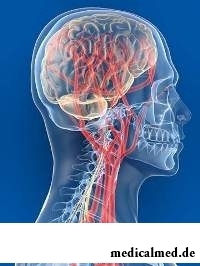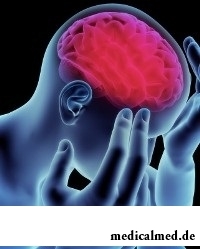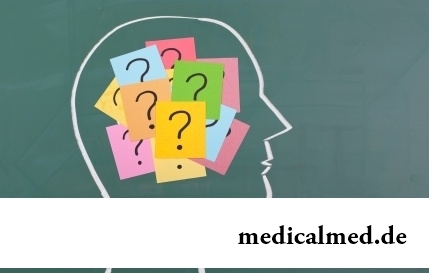





Angiodystonia
Angiodystonia (vascular dystonia) – the disturbance of tonic adaptation function of blood vessels caused by disturbance of a structure of walls of vessels, and also development of a muscular layer, which is characterized by inadequacy, insufficiency or redundancy of function that is shown as regional (local) or general disturbance of a blood-groove. The angiodystonia can strike both arterial, and venous vessels.
 Vascular tone – the main function of unstriated muscles of a vascular wall which provides mechanical characteristics and geometrical parameters of walls and gleams of vessels.
Vascular tone – the main function of unstriated muscles of a vascular wall which provides mechanical characteristics and geometrical parameters of walls and gleams of vessels.
Cerebral angiodystonia – the disturbance of tonic function of vessels of a brain which is shown a characteristic symptomatic complex.
Angiodystonia – frustration of a tone of vessels of various etiology (functional, organic), localizations, the development mechanism. The angiodystonia is not an independent disease, and in most cases acts as the accompanying (secondary) complex of symptoms, the disturbances caused by a basic disease. The angiodystonia is observed against the background of the following diseases:
- Pathology of closed glands (ovaries, adrenal glands, hypophysis, thyroid gland);
- Dysfunction of the autonomic nervous system;
- Focal infections;
- Diseases of internals (amyloidosis, gastrointestinal diseases, pancreatitis, atherosclerosis and other);
- Diseases of a nervous system, injury of the head, concussion in the anamnesis;
- Allergic reactions;
- Hypodynamia;
- Chronic infectious processes;
- Features of the identity of the patient (the increased suspiciousness, irritability, special degree of uneasiness).
The angiodystonia is inherent more in adults, however recently is even more often diagnosed for children of school age.
The angiodystonia is classified by the following indicators:
- On an etiology and a pathogeny distinguish primary (neurogenic) and symptomatic angiodystonia;
- On localization distinguish the localized (monoregional) disturbance and a polyregional (system) angiodystonia;
- On character of a current distinguish permanent disturbances and angioditonichsky crisis;
- On the arterial pressure against the background of which disturbance of a tone of vessels develops distinguish an angiodystonia against the background of a normotenziya, disturbances against the background of hypertensia or against the background of hypotension.
Characteristic signs of an angiodystonia
The main signs of an angiodystonia are headaches of various character and an etiology, differences of arterial pressure, dizziness, sleeplessness, numbness of extremities, a systematic sonitus. The feeling of weight in the head develops. Some patients note a memory impairment, disturbance of visual function, hearing, sense of smell. In certain cases signs of an angiodystonia are extremity, neck, spin pains.
The headache which is an angiodystonia sign is localized in a temporal and temporoparietal part of the head. Pain can be the stupid, aching, shooting character.
In rare instances one of possible symptoms of an angiodystonia is the depression which is characterized by loss of control over an emotional state, breath difficulty. The depression at an angiodystonia develops against the background of the wearisome headache breaking a human life rhythm. Often the headache is not associated with fatigue, a stress. Pain can arise at any time, even after long rest, at rest.
As a rule, signs of an angiodystonia are shown in total that facilitates disturbance diagnosis.
Angiodystonia signs when reading results of clinical trials are:
- Change of diameter and gleam of a vessel;
- Depletion of a blood-groove;
- Shift of vessels.
Cerebral angiodystonia: disturbance development effects
The cerebral angiodystonia can develop as owing to various disturbances in an organism (internal factors), and owing to influence of external factors (for example, stressful situations, the use of heavy food).
The cerebral angiodystonia demands careful diagnosis. In cases of lack of adequate treatment against the background of an angiodystonia encephalopathy – a disease of a brain of noninflammatory character can develop. Encephalopathy against the background of a cerebral angiodystonia is shown by the following symptoms:
- Chronic depressions;
- Frequent headaches against the background of a stress, fatigue;
- Disorders of consciousness, memory;
- Dizzinesses;
- Lack of an initiative.
Increased fatigue, differences of mood, weight in the head, a sleep disorder and other inherent angiodystonias signs can also be the accompanying symptoms.
Angiodystonia: disturbance diagnosis
At suspicion on an angiodystonia performing comprehensive examination is necessary. The main diagnostic methods of an angiodystonia are noninvasive techniques, one of which is the rheoencephalography – the research of brain vessels based on monitoring of changes of sizes of resistance of fabrics at impact on them of weak electric impulses of high frequency. Thus, it is possible to obtain the objective information about the vascular device of a brain: vascular tone, reactivity of vessels of a brain, elasticity of their walls, size of a pulse krovenapolneniye.
Also in diagnosis of an angiodystonia the following methods will be applied:
- Ultrasonic examination of arterial and peripheral vessels;
- Screening of ischemic changes of a myocardium by means of an ECG.
Also at suspicion on an angiodystonia it is necessary to differentiate symptoms with symptoms of psychosomatic diseases.
Angiodystonia: treatment and forecasts
The angiodystonia is not an independent disease. This disturbance has the secondary nature, developing against the background of other diseases that defines treatment tactics at an angiodystonia. So, first of all at an angiodystonia treatment has to be directed to elimination of a basic disease.
 At the diagnosed angiodystonia treatment has to take place in the following directions:
At the diagnosed angiodystonia treatment has to take place in the following directions:
- Definition and the choice of optimum therapy of the basic disease provoking development of an angiodystonia;
- The therapy directed to normalization of a tone of vessels (for example, LFK directed to a training of vascular reactions);
- Symptomatic treatment of an angiodystonia;
- Change of a way of life (normalization of a sleep pattern and rest, disposal of addictions, change of a food allowance).
The angiodystonia demands continuous monitoring from the attending physician even at total absence of a symptomatic complex.
In rare instances the angiodystonia which treatment has to be complex can become the reason of total loss of working capacity the patient at a pronounced symptomatic complex. Now there are no criteria of the choice of optimum medicines for treatment of disturbance and elimination of symptoms. At an angiodystonia treatment is selected individually taking into account reactions of an organism to complex therapy.
In our intestines are born, millions of bacteria live and die. They can be seen only at strong increase, but if they gathered, then would be located in a usual coffee cup.

Osteoporosis this general disease which main sign is decrease in density of a bone tissue. On width распростран...
Section: Articles about health
Deciding to get rid of an addiction, not all imagine what effects it is necessary to face. Process of refusal of smoking causes quite essential discomfort in most of people: differences of mood, sleep disorder, fatigue, decrease физич...
Section: Articles about health
According to doctors, more than a half of men of 25-50 years suffer from frustration of the urinogenital sphere, but the minority sees a doctor from them. And in vain - even the insignificant discomfort in the field of generative organs can serve as a symptom of an illness fraught with grave consequences for health. So - after 40 years - it is easy for most widespread disease of the sexual sphere of men to pass the first symptoms of prostatitis (weight in the bottom of a stomach, decrease in a libido), having written off for overfatigue and fatigue. Let's consider...
Section: Articles about health
The phenomenon of improvement of a condition of the patients at administration of drugs who are not containing active agents, so-called effect of placebo is known...
Section: Articles about health
There is a lot of fans of beer in our country. Statistically, on each average Russian (including women and children) in a year about 60 liters of this drink are consumed. It is not a lot of, as in the Czech Republic or Germany, but figure all the same impressive. Radova...
Section: Articles about health
One of the useful properties presented to the person by the nature is ability to feel fear. This ability is designed to signal about approach of a dangerous situation and to help to avoid in advance it to keep life. However if the fear is persuasive and is not reasonable, it can seriously limit possibilities of the person in respect of socialization and self-realization. Such pathological fear is called a phobia....
Section: Articles about health
Stroke (acute disorder of cerebral circulation) – one of the most widespread neurologic diseases. Annually in the world...
Section: Articles about health
Several decades ago the basil (the district khan, реан, Reagan) was considered as a part of the Caucasian or east cuisine, but today it strongly took the place on tables of Russians. Greens of this plant possess a strong, pleasant smell and specific fresh taste, because of to...
Section: Articles about health
Diapers for adults – individual one-time means of hygiene which in some situations is irreplaceable and from such situations any person is not insured. Though nobody perceives need of their use with enthusiasm, however without such means already problematic situation could be heavier....
Section: Articles about health
Scientists always aimed to offer fundamental explanations for medical problems. Their theories formed the basis of modern methods is treated...
Section: Articles about health
The way of life of people promptly changes from year to year: if about ten years ago the personal computer was not in each family, then today already very few people do without this device. Certainly, and children master the computer at full speed: they not only I play...
Section: Articles about health
Stability of a hormonal background is one of the most important conditions of preservation of health of the woman. At the same time endocrine system – the thin device extremely sensitive to any external influences. Changes of a way of life (for example, a diet), emotional stresses, infectious diseases, reception of some drugs can become the reason of hormonal failure. Besides, work of hemadens has the natural specifics in certain moments of life: on various St...
Section: Articles about health
There is an opinion that at low temperatures safety of products is ensured longer and better thanks to what the refrigerator considers...
Section: Articles about health
High temperature - a frequent symptom of such widespread diseases as a SARS, quinsy, pneumonia, etc. To reduce heat, having facilitated a condition of the patient, doctors recommend to accept antipyretics, however their use is not always possible. Too h...
Section: Articles about health
From the failure of work of immune system which is shown in the form of an allergy, statistically, more than 40% of the population of the globe suffer. In most cases pathological reactions cause the substances which are contained in food stuffs, hair of animals, medicines, goods of household chemicals, cosmetics, pollen of plants, etc. On the one hand, the disease such is capable to spoil quite thoroughly to the person life....
Section: Articles about health
Diseases of joints often begin imperceptibly for the person. The first stages of destruction of the cartilaginous tissue providing soft and свободн...
Section: Articles about health
So, you resolved to lose weight. And now you try to understand what to begin with: from exercise stresses or a diet? And how to make that process of weight loss did not give you an inconvenience, and, on the contrary, brought joy?...
Section: Slideshow
Water with a lemon - idle time in preparation drink which supporters of a healthy lifestyle already managed to appreciate. Used in a warm look and on an empty stomach, it is one of the most useful prophylactics allowing to prevent tens of diseases and just to raise an organism tone. Especially effectively to use warm water with lemon juice after a serious illness, during a season of the colds, and also to children, old men and pregnant women which do not have contraindications...
Section: Articles about health
The problem of diagnosis was and remains to one of the most important in medicine. From that, the reason недо will be how precisely defined...
Section: Articles about health
It is pleasant to state a possibility of improvement of quality of life of people with problems of functioning of secretory system. Efforts of talented inventors created products which will be able to provide normal life activity of clients with moderate degree for...
Section: Articles about health
The thought that the mass of their body is too big at least once in life visits from 80 to 95% of women. Many women are so obsessed with this idea that constantly try all new and new ways of weight reduction. A considerable part of these techniques is ineffective, and some in general are unsafe for health....
Section: Articles about health
The hysteromyoma is diagnosed more than at a third of women 35 years are more senior. This high-quality new growth, which on early a stage...
Section: Articles about health
The cosmetics intended for improvement of a condition of skin, nails and hair are used by each woman. Expenses on regular acquisition of the fashionable widely advertized products of well-known companies for many become very notable and significantly to an obrema...
Section: Articles about health
Sometimes it seems that modern society was divided into two camps: representatives of the first are sure that only the woman has to be responsible for contraception, representatives of the second, respectively, are sure that it is destiny of men. Meanwhile the question of contraception has very many aspects – both psychological, and legal and, of course, medical....
Section: Articles about health
Memory is an ability of the central nervous system to fix, keep and as necessary to reproduce information on knowledge...
Section: Articles about health
Smoking not only exerts a negative impact on the state of health of the consumer of tobacco products, but is an air polluter the substances potentially dangerous to people around. In recent years significantly the number of people, стремящ increased...
Section: Articles about health
Feeding by a breast - the integral part of ideal motherhood allowing to come into contact with the kid and to create to it healthy immunity since early years. Nevertheless, this important process in life of mother and child can be saddened laktostazy − by a milk delay in a mammary gland. What main reasons for a laktostaz? How not to allow problems with breastfeeding? Let's consider 10 premises resulting in stagnation of milk at the nursing mother....
Section: Articles about health
